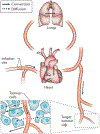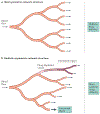Transport of drugs from blood vessels to tumour tissue
- PMID: 29123246
- PMCID: PMC6371795
- DOI: 10.1038/nrc.2017.93
Transport of drugs from blood vessels to tumour tissue
Abstract
The effectiveness of anticancer drugs in treating a solid tumour is dependent on delivery of the drug to virtually all cancer cells in the tumour. The distribution of drug in tumour tissue depends on the plasma pharmacokinetics, the structure and function of the tumour vasculature and the transport properties of the drug as it moves through microvessel walls and in the extravascular tissue. The aim of this Review is to provide a broad, balanced perspective on the current understanding of drug transport to tumour cells and on the progress in developing methods to enhance drug delivery. First, the fundamental processes of solute transport in blood and tissue by convection and diffusion are reviewed, including the dependence of penetration distance from vessels into tissue on solute binding or uptake in tissue. The effects of the abnormal characteristics of tumour vasculature and extravascular tissue on these transport properties are then discussed. Finally, methods for overcoming limitations in drug transport and thereby achieving improved therapeutic results are surveyed.
Conflict of interest statement
Competing interests statement
T.W.S. has no conflicts of interest. M.W.D. was involved in the development of the thermally sensitive liposome described in this paper and has stock in Celsion Corporation, the company that licensed the drug. M.W.D. is also a consultant for Siva Therapeutics and Kaio Therapy and a member of the Scientific Advisory Board of Innovate Biopharmaceuticals.
Figures




Similar articles
-
Computational modelling of drug delivery to solid tumour: Understanding the interplay between chemotherapeutics and biological system for optimised delivery systems.Adv Drug Deliv Rev. 2018 Jul;132:81-103. doi: 10.1016/j.addr.2018.07.013. Epub 2018 Jul 29. Adv Drug Deliv Rev. 2018. PMID: 30059703 Review.
-
Determinants of drug delivery and transport to solid tumors.J Control Release. 2001 Jul 6;74(1-3):31-46. doi: 10.1016/s0168-3659(01)00308-x. J Control Release. 2001. PMID: 11489481 Review.
-
Drug delivery and transport to solid tumors.Pharm Res. 2003 Sep;20(9):1337-50. doi: 10.1023/a:1025785505977. Pharm Res. 2003. PMID: 14567626 Review.
-
Delivery of molecular and nanoscale medicine to tumors: transport barriers and strategies.Annu Rev Chem Biomol Eng. 2011;2:281-98. doi: 10.1146/annurev-chembioeng-061010-114300. Annu Rev Chem Biomol Eng. 2011. PMID: 22432620 Review.
-
In-silico dynamic analysis of cytotoxic drug administration to solid tumours: Effect of binding affinity and vessel permeability.PLoS Comput Biol. 2018 Oct 8;14(10):e1006460. doi: 10.1371/journal.pcbi.1006460. eCollection 2018 Oct. PLoS Comput Biol. 2018. PMID: 30296260 Free PMC article.
Cited by
-
Cancer stem cells and strategies for targeted drug delivery.Drug Deliv Transl Res. 2021 Oct;11(5):1779-1805. doi: 10.1007/s13346-020-00863-9. Epub 2020 Oct 23. Drug Deliv Transl Res. 2021. PMID: 33095384 Free PMC article. Review.
-
Externally triggered smart drug delivery system encapsulating idarubicin shows superior kinetics and enhances tumoral drug uptake and response.Theranostics. 2021 Mar 31;11(12):5700-5712. doi: 10.7150/thno.55163. eCollection 2021. Theranostics. 2021. PMID: 33897876 Free PMC article.
-
Graphene Oxide/Chitosan Injectable Composite Hydrogel for Controlled Release of Doxorubicin: An Approach for Enhanced Intratumoral Delivery.Nanomaterials (Basel). 2022 Nov 30;12(23):4261. doi: 10.3390/nano12234261. Nanomaterials (Basel). 2022. PMID: 36500884 Free PMC article.
-
Bystander Effects of Hypoxia-Activated Prodrugs: Agent-Based Modeling Using Three Dimensional Cell Cultures.Front Pharmacol. 2018 Sep 18;9:1013. doi: 10.3389/fphar.2018.01013. eCollection 2018. Front Pharmacol. 2018. PMID: 30279659 Free PMC article.
-
Signature of the vascular tumor microenvironment as a marker of the therapeutic response to doxorubicin in a preclinical model of osteosarcoma.Am J Cancer Res. 2022 Apr 15;12(4):1843-1854. eCollection 2022. Am J Cancer Res. 2022. PMID: 35530297 Free PMC article.
References
-
- Bast RC et al. Holland-Frei Cancer Medicine 9th edn Wiley-Blackwell, 2017).
-
- Swabb EA, Wei J & Gullino PM Diffusion and convection in normal and neoplastic tissues. Cancer Res 34, 2814–2822 (1974). - PubMed
-
In this early account of how tissue glycosaminoglycan content can affect solute transport by convection compared with by diffusion in tumours, the authors suggest that degradation of glycosaminoglycan with hyaluronidase could improve solute transport in tumours.
-
- Jain RK Transport of molecules across tumor vasculature. Cancer Metastasis Rev 6, 559–593 (1987). - PubMed
-
This comprehensive review discusses the transport properties of microvessel walls with respect to their importance for drugs of various sizes.
-
- Jain RK Transport of molecules in the tumor interstitium: a review. Cancer Res 47, 3039–3051 (1987). - PubMed
-
This review focuses on factors that impede solute transport in the interstitium of tumours and shows how high IFP and lack of functioning lymphatics contribute to reduced transport.
-
- Jain RK The Eugene M. Landis Award Lecture 1996. Delivery of molecular and cellular medicine to solid tumors. Microcirculation 4, 1–23 (1997). - PubMed
Publication types
MeSH terms
Substances
Grants and funding
LinkOut - more resources
Full Text Sources
Other Literature Sources

